2007 GMC ACADIA key
[x] Cancel search: keyPage 1 of 554

Seats and Restraint Systems
........................ 7
Front Seats
.............................................. 9
Rear Seats
............................................. 18
Safety Belts
............................................ 24
Child Restraints
...................................... 48
Airbag System
........................................ 76
Restraint System Check
......................... 92
Features and Controls
................................. 95
Keys
....................................................... 97
Doors and Locks
.................................. 106
Windows
............................................... 114
Theft-Deterrent Systems
....................... 118
Starting and Operating Your Vehicle
..... 123
Mirrors
.................................................. 140
OnStar
®System
................................... 145
Universal Home Remote System
.......... 149
Storage Areas
...................................... 161
Sunroof
................................................ 164Instrument Panel
........................................ 167
Instrument Panel Overview
................... 170
Climate Controls
................................... 199
Warning Lights, Gages, and Indicators
... 214
Driver Information Center (DIC)
............ 232
Audio System(s)
................................... 264
Driving Your Vehicle
.................................. 329
Your Driving, the Road, and
Your Vehicle
..................................... 330
Towing
................................................. 367
Service and Appearance Care
................... 383
Service
................................................. 385
Fuel
...................................................... 387
Checking Things Under the Hood
......... 394
All-Wheel Drive
..................................... 430
Headlamp Aiming
................................. 431
Bulb Replacement
................................ 432
Windshield Wiper Blade Replacement
... 434
2007 GMC Acadia Owner ManualM
1
Page 13 of 554

The heated seats will turn off ten seconds after
the ignition is turned off. If you want to use
the heated seat feature after you restart your
vehicle, you will need to press the heated seat
or seatback button again.
If your vehicle has remote vehicle start and is
started using the remote keyless entry transmitter,
the front heated seats will be turned on to the
high setting if it is cold outside. See “Remote
Vehicle Start” underRemote Keyless Entry (RKE)
System Operation on page 100. When the key is
inserted into the ignition and the ignition is turned
on, the heated seat feature will turn off. To turn
the heated seat feature back on, press the
desired button.Memory Seat and Mirrors
Your vehicle may have the memory package.
The controls for this feature are located on the
driver’s door panel, and are used to program and
recall memory settings for the driver’s seat and
outside mirrors.
To save your positions in memory, do the
following:
1. Adjust the driver’s seat, including the seatback
recliner and lumbar and both outside mirrors
to a comfortable position.
SeeOutside Power Mirrors on page 142for
more information.
Not all mirrors will have the ability to save and
recall the mirror positions.
2. Press and hold button 1 until two beeps let
you know that the position has been stored.
13
Page 14 of 554
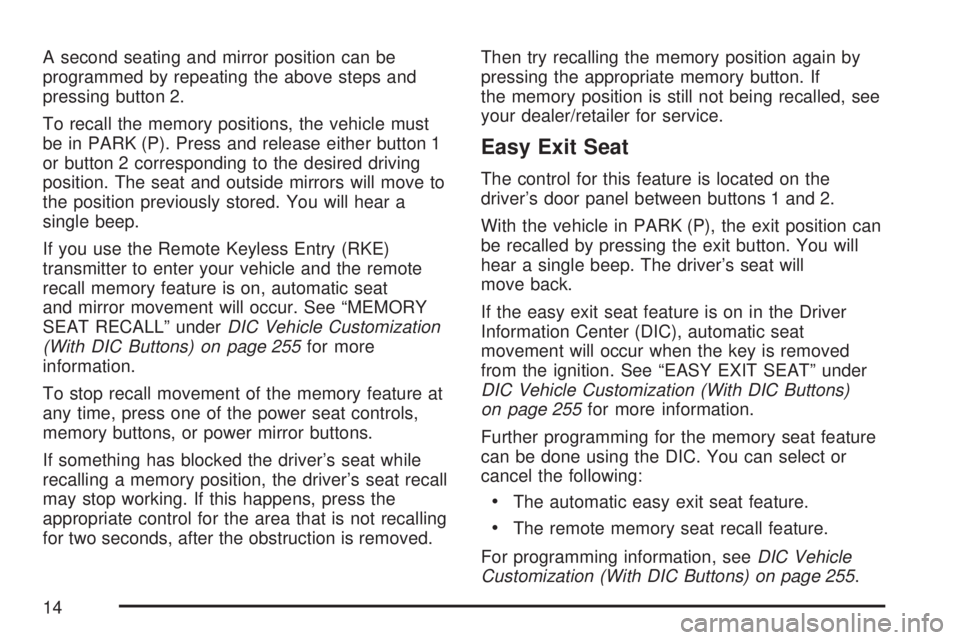
A second seating and mirror position can be
programmed by repeating the above steps and
pressing button 2.
To recall the memory positions, the vehicle must
be in PARK (P). Press and release either button 1
or button 2 corresponding to the desired driving
position. The seat and outside mirrors will move to
the position previously stored. You will hear a
single beep.
If you use the Remote Keyless Entry (RKE)
transmitter to enter your vehicle and the remote
recall memory feature is on, automatic seat
and mirror movement will occur. See “MEMORY
SEAT RECALL” underDIC Vehicle Customization
(With DIC Buttons) on page 255for more
information.
To stop recall movement of the memory feature at
any time, press one of the power seat controls,
memory buttons, or power mirror buttons.
If something has blocked the driver’s seat while
recalling a memory position, the driver’s seat recall
may stop working. If this happens, press the
appropriate control for the area that is not recalling
for two seconds, after the obstruction is removed.Then try recalling the memory position again by
pressing the appropriate memory button. If
the memory position is still not being recalled, see
your dealer/retailer for service.
Easy Exit Seat
The control for this feature is located on the
driver’s door panel between buttons 1 and 2.
With the vehicle in PARK (P), the exit position can
be recalled by pressing the exit button. You will
hear a single beep. The driver’s seat will
move back.
If the easy exit seat feature is on in the Driver
Information Center (DIC), automatic seat
movement will occur when the key is removed
from the ignition. See “EASY EXIT SEAT” under
DIC Vehicle Customization (With DIC Buttons)
on page 255for more information.
Further programming for the memory seat feature
can be done using the DIC. You can select or
cancel the following:
The automatic easy exit seat feature.
The remote memory seat recall feature.
For programming information, seeDIC Vehicle
Customization (With DIC Buttons) on page 255.
14
Page 21 of 554
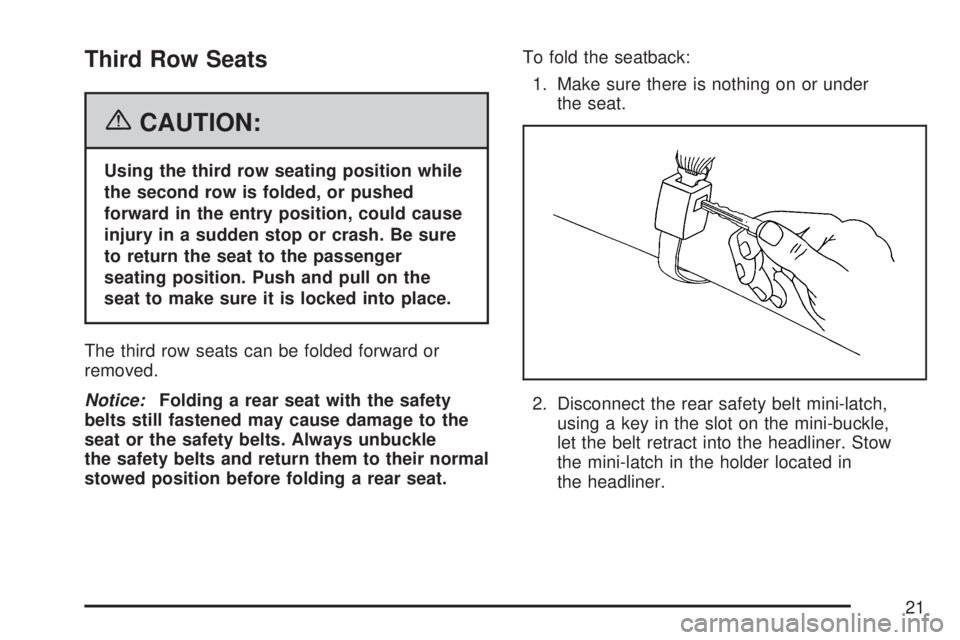
Third Row Seats
{CAUTION:
Using the third row seating position while
the second row is folded, or pushed
forward in the entry position, could cause
injury in a sudden stop or crash. Be sure
to return the seat to the passenger
seating position. Push and pull on the
seat to make sure it is locked into place.
The third row seats can be folded forward or
removed.
Notice:Folding a rear seat with the safety
belts still fastened may cause damage to the
seat or the safety belts. Always unbuckle
the safety belts and return them to their normal
stowed position before folding a rear seat.To fold the seatback:
1. Make sure there is nothing on or under
the seat.
2. Disconnect the rear safety belt mini-latch,
using a key in the slot on the mini-buckle,
let the belt retract into the headliner. Stow
the mini-latch in the holder located in
the headliner.
21
Page 39 of 554
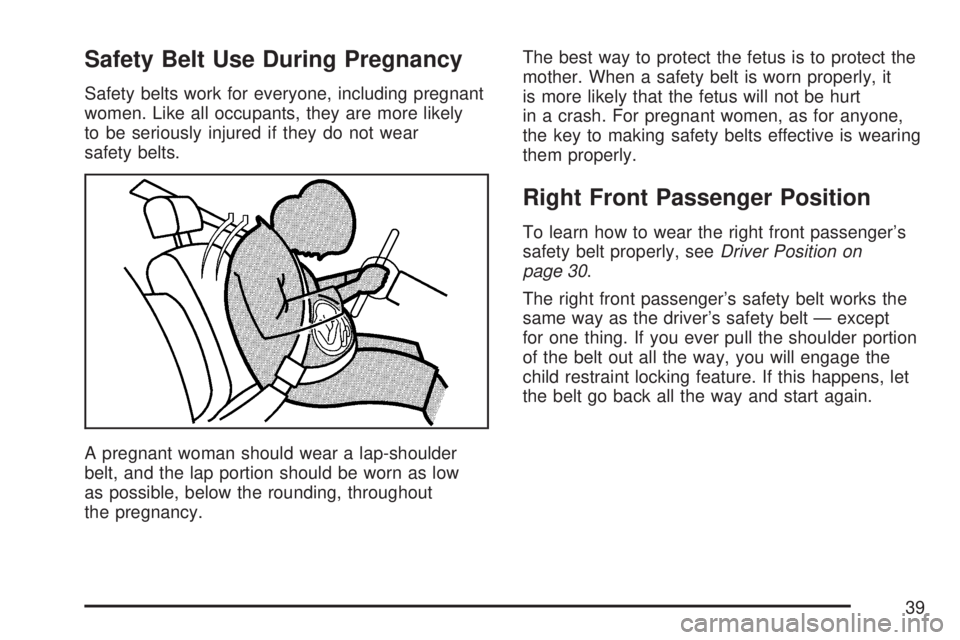
Safety Belt Use During Pregnancy
Safety belts work for everyone, including pregnant
women. Like all occupants, they are more likely
to be seriously injured if they do not wear
safety belts.
A pregnant woman should wear a lap-shoulder
belt, and the lap portion should be worn as low
as possible, below the rounding, throughout
the pregnancy.The best way to protect the fetus is to protect the
mother. When a safety belt is worn properly, it
is more likely that the fetus will not be hurt
in a crash. For pregnant women, as for anyone,
the key to making safety belts effective is wearing
them properly.
Right Front Passenger Position
To learn how to wear the right front passenger’s
safety belt properly, seeDriver Position on
page 30.
The right front passenger’s safety belt works the
same way as the driver’s safety belt — except
for one thing. If you ever pull the shoulder portion
of the belt out all the way, you will engage the
child restraint locking feature. If this happens, let
the belt go back all the way and start again.
39
Page 95 of 554

Keys.............................................................. 97
Remote Keyless Entry (RKE) System.......... 98
Remote Keyless Entry (RKE) System
Operation............................................... 100
Doors and Locks........................................ 106
Door Locks................................................ 106
Power Door Locks..................................... 107
Delayed Locking........................................ 107
Programmable Automatic Door Locks........ 107
Rear Door Security Locks......................... 108
Lockout Protection..................................... 108
Liftgate...................................................... 109
Power Liftgate........................................... 110
Windows...................................................... 114
Power Windows........................................ 115
Sun Visors................................................ 117Theft-Deterrent Systems............................. 118
Content Theft-Deterrent............................. 118
PASS-Key
®III+......................................... 120
PASS-Key®III+ Operation......................... 121
Starting and Operating Your Vehicle......... 123
New Vehicle Break-In................................ 123
Ignition Positions....................................... 124
Retained Accessory Power (RAP)............. 125
Starting the Engine.................................... 126
Engine Coolant Heater.............................. 127
Automatic Transmission Operation............. 129
Tow/Haul Mode......................................... 133
Parking Brake........................................... 134
Shifting Into Park (P)................................. 135
Shifting Out of Park (P)............................. 137
Parking Over Things That Burn................. 137
Engine Exhaust......................................... 138
Running the Engine While Parked............. 139
Section 2 Features and Controls
95
Page 97 of 554
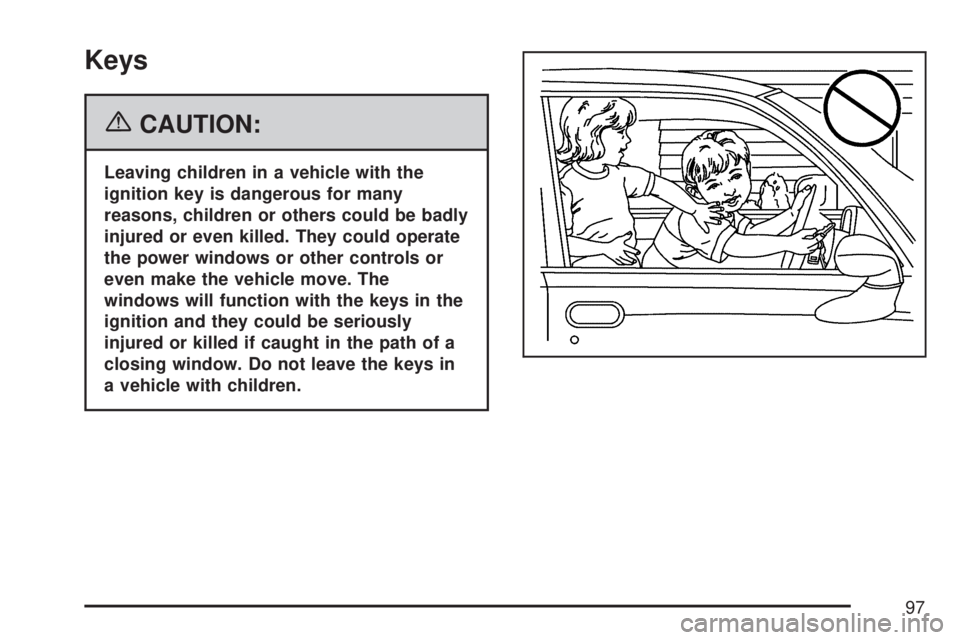
Keys
{CAUTION:
Leaving children in a vehicle with the
ignition key is dangerous for many
reasons, children or others could be badly
injured or even killed. They could operate
the power windows or other controls or
even make the vehicle move. The
windows will function with the keys in the
ignition and they could be seriously
injured or killed if caught in the path of a
closing window. Do not leave the keys in
a vehicle with children.
97
Page 98 of 554
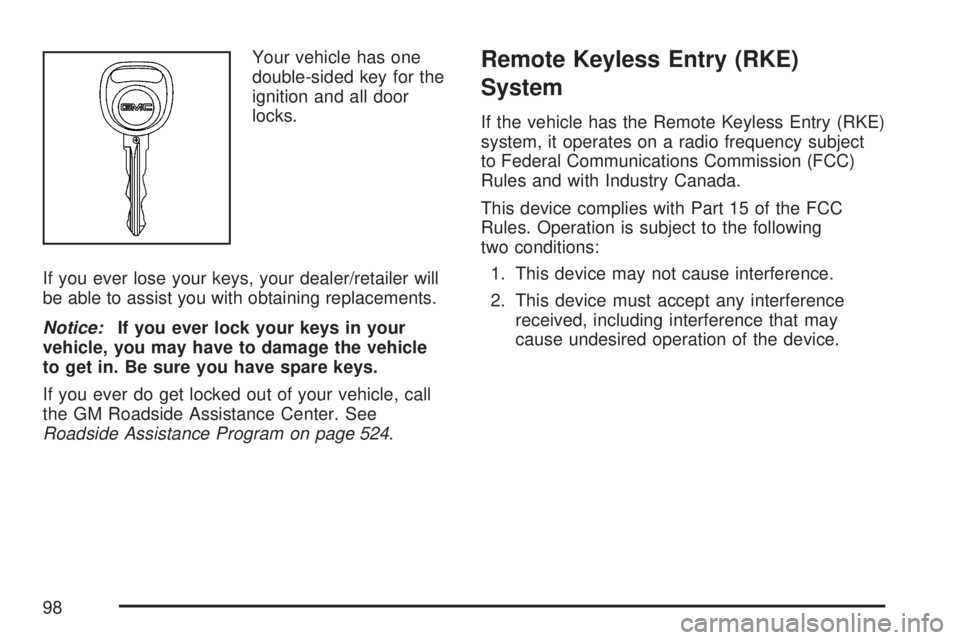
Your vehicle has one
double-sided key for the
ignition and all door
locks.
If you ever lose your keys, your dealer/retailer will
be able to assist you with obtaining replacements.
Notice:If you ever lock your keys in your
vehicle, you may have to damage the vehicle
to get in. Be sure you have spare keys.
If you ever do get locked out of your vehicle, call
the GM Roadside Assistance Center. See
Roadside Assistance Program on page 524.Remote Keyless Entry (RKE)
System
If the vehicle has the Remote Keyless Entry (RKE)
system, it operates on a radio frequency subject
to Federal Communications Commission (FCC)
Rules and with Industry Canada.
This device complies with Part 15 of the FCC
Rules. Operation is subject to the following
two conditions:
1. This device may not cause interference.
2. This device must accept any interference
received, including interference that may
cause undesired operation of the device.
98